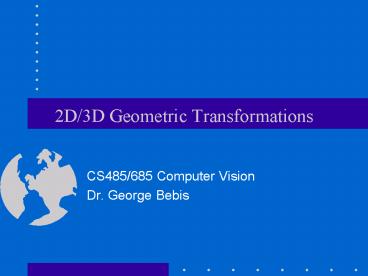2D/3D Geometric Transformations - PowerPoint PPT Presentation
Title:
2D/3D Geometric Transformations
Description:
Moves a point to a new location by adding translation amounts to the coordinates ... Changes the size of the object by multiplying the coordinates of the points ... – PowerPoint PPT presentation
Number of Views:47
Avg rating:3.0/5.0
Title: 2D/3D Geometric Transformations
1
2D/3D Geometric Transformations
- CS485/685 Computer Vision
- Dr. George Bebis
2
2D Translation
- Moves a point to a new location by adding
translation amounts to the coordinates of the
point.
or
or
3
2D Translation (contd)
- To translate an object, translate every point of
the object by the same amount.
4
2D Scaling
- Changes the size of the object by multiplying the
coordinates of the points by scaling factors.
or
or
5
2D Scaling (contd)
- Uniform vs non-uniform scaling
- Effect of scale factors
6
2D Rotation
- Rotates points by an angle ? about origin
- (? gt0 counterclockwise rotation)
- From ABP triangle
B
C
- From ACP triangle
A
7
2D Rotation (contd)
- From the above equations we have
or
or
8
Summary of 2D transformations
- Use homogeneous coordinates to express
translation as - matrix multiplication
9
Homogeneous coordinates
- Add one more coordinate (x,y) ? (xh, yh, w)
- Recover (x,y) by homogenizing (xh, yh, w)
- So, xhxw, yhyw,
- (x, y) ? (xw, yw, w)
10
Homogeneous coordinates (contd)
- (x, y) has multiple representations in
homogeneous coordinates - w1 (x,y) ? (x,y,1)
- w2 (x,y) ? (2x,2y,2)
- All these points lie on a
- line in the space of
- homogeneous
- coordinates !!
projective space
11
2D Translation using homogeneous coordinates
w1
12
2D Translation using homogeneous coordinates
(contd)
- Successive translations
13
2D Scaling using homogeneous coordinates
w1
14
2D Scaling using homogeneous coordinates (contd)
- Successive scalings
15
2D Rotation using homogeneous coordinates
w1
16
2D Rotation using homogeneous coordinates
(contd)
- Successive rotations
or
17
Composition of transformations
- The transformation matrices of a series of
transformations can be concatenated into a single
transformation matrix.
Translate P1 to origin Perform scaling and
rotation Translate to P2
Example
18
Composition of transformations (contd)
- Important preserve the order of transformations!
translation rotation
rotation translation
19
General form of transformation matrix
translation
rotation, scale
- Representing a sequence of transformations as a
single transformation matrix is more
efficient!
(only 4 multiplications and 4 additions)
20
Special cases of transformations
- Rigid transformations
- Involves only translation and rotation (3
parameters) - Preserve angles and lengths
upper 2x2 submatrix is ortonormal
21
Example rotation matrix
22
Special cases of transformations
- Similarity transformations
- Involve rotation, translation, scaling (4
parameters) - Preserve angles but not lengths
23
Affine transformations
- Involve translation, rotation, scale, and shear
- (6 parameters)
- Preserve parallelism of lines but not lengths and
angles.
24
2D shear transformation
changes object shape!
- Shearing along x-axis
- Shearing along y-axis
25
Affine Transformations
- Under certain assumptions, affine transformations
can be used to approximate the effects of
perspective projection!
affine transformed object
G. Bebis, M. Georgiopoulos, N. da Vitoria Lobo,
and M. Shah, " Recognition by learning affine
transformations", Pattern Recognition, Vol. 32,
No. 10, pp. 1783-1799, 1999.
26
Projective Transformations
projective (8 parameters)
affine (6 parameters)
27
3D Transformations
- Right-handed / left-handed systems
28
3D Transformations (contd)
- Positive rotation angles for right-handed
systems
(counter-clockwise rotations)
29
Homogeneous coordinates
- Add one more coordinate (x,y,z) ? (xh, yh, zh,w)
- Recover (x,y,z) by homogenizing (xh, yh, zh,w)
- In general, xhxw, yhyw, zhzw
- (x, y,z) ? (xw, yw, zw, w)
- Each point (x, y, z) corresponds to a line in the
4D-space of homogeneous coordinates.
30
3D Translation
31
3D Scaling
32
3D Rotation
- Rotation about the z-axis
33
3D Rotation (contd)
- Rotation about the x-axis
34
3D Rotation (contd)
- Rotation about the y-axis
35
Change of coordinate systems
- Suppose that the coordinates of P3 are given in
the xyz coordinate system - How can you compute its coordinates in the RxRyRz
coordinate system? - (1) Recover the translation T and
- rotation R from RxRyRz to xyz.
- that aligns RxRyRz with xyz
- (2) Apply T and R on P3 to compute
- its coordinates in the RxRyRz system.
36
(1.1) Recover translation T
- If we know the coordinates of P1 (i.e., origin of
RxRyRz) in the xyz coordinate system, then T is
37
(1.2) Recover rotation R
- ux, uy, uz are unit vectors in the xyz
coordinate system. - rx, ry, rz are unit vectors in the RxRyRz
coordinate system - (rx, ry, rz are represented in the xyz
coordinate system) - Find rotation R rz ?uz , rx?ux, and ry? uy
R
38
Change of coordinate systemsrecover rotation R
(contd)
uz
ux
uy
39
Change of coordinate systemsrecover rotation R
(contd)
Thus, the rotation matrix R is given by
40
Change of coordinate systemsrecover rotation R
(contd)
- Verify that it performs the correct mapping
rx ? ux
ry ? uy
rz ? uz






























